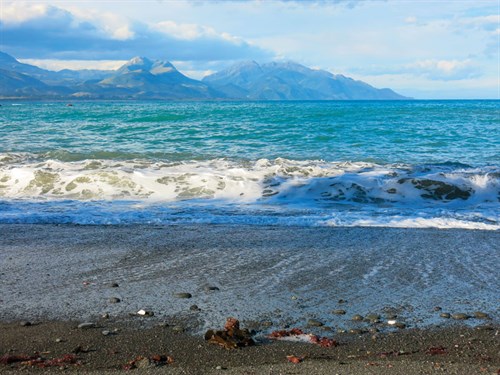
Probably the best time to view the magnificent Kaikoura Coast is when the southerlies roll up to the rocks in such style that even the seals take shelter.
Towering behind the stretch of SH1 that follows the coast between Waipapa Bay and Oaro, just north of the Haumuri Bluff, the Kaikoura Ranges are the highest part of land so close to the sea anywhere in New Zealand. So wherever you pull up, the dominant impression will be a unique combination of ocean and mountains.
In winter, this can be an awesome sight as snow-capped peaks loom over the wild seascape. But just as often, calm seas mirror a patchwork of farms and forests, as well as the hopes of hordes of fishermen.
Off the rocky peninsula, where the Kaikoura township nestles, lives an abundance of marine life. Kaikoura means ‘meal of crayfish’ in Mãori, and fishing has always been a serious business here, ever since moa hunter Mãori first occupied the area more than 950 years ago.
This is where two great ocean currents converge, one subtropical and the other sub-Antarctic, making the sea so rich in minerals and plankton that it provides a constantly rich habitat for marine mammals and seabirds.
On these natural phenomena, much curious human history is based. After Captain Cook sailed past in 1770, bemusing the tangata whenua (local people), the Ngai Tahu tribe was decimated by North Island Mãori, led by their chief Te Rauparaha about 1828. Then in 1843 the first whaling station was set up by Robert Fyffe, and immigrants, many of them Irish, gathered near the peninsula to make farming and fishing their way of life.
The days of wholesale slaughter are long gone, but sperm whales, more accessible here than anywhere else in the world, continue to bring prosperity to the region. Visitors arriving to share these natural wonders have provided a springboard for award-winning Mãori entrepreneurs to develop a sustainable travel and tourism industry.
This is a place where whale watching by sea or air, or swimming with dolphins and seals, provides people from all over the world with unforgettable experiences. And if you stop your motorhome at the Peketa Beach Holiday Park, seven kilometres south of the Kaikoura township, you may even see dolphins as you relax at your campsite.
Formerly operated by the Department of Conservation, the property has been owned by Ngai Tahu since 1998, and since 2001 has been leased from them by Digby and Eve Parkin.
This is Kaikoura’s only beach camp setting, designated to remain as a reserve for the people. But Digby and Eve have taken to heart the wish of overseas visitors to see the sea right outside their window.
Most of the on-site boats and caravans at Peketa are owned by Christchurch residents who flock to Peketa Beach at weekends and holiday times to fish for blue cod, groper, and perch, and dive for paua and crayfish, and interested spectators often see the results at the camp’s fish filleting areas.
Close by the camp, opposite the mouth of the Kahutara River, is the second hottest spot for board riders along the surging Kaikoura Coast, and that explains why Digby also provides three wetsuit wash areas for visitors.
But there are eight registered camping grounds in the Kaikoura area, all offering motorhome visitors the chance to enjoy the seaside Kaikoura lifestyle for as long as they wish.
Along the beachfront, a number of monuments record the area’s history and, on the peninsula itself, the remains of several Mãori pa sites can still be identified. Kaikoura’s whaling history is reflected in exhibits and displays at both the Kaikoura Museum and the historic Fyffe House.






